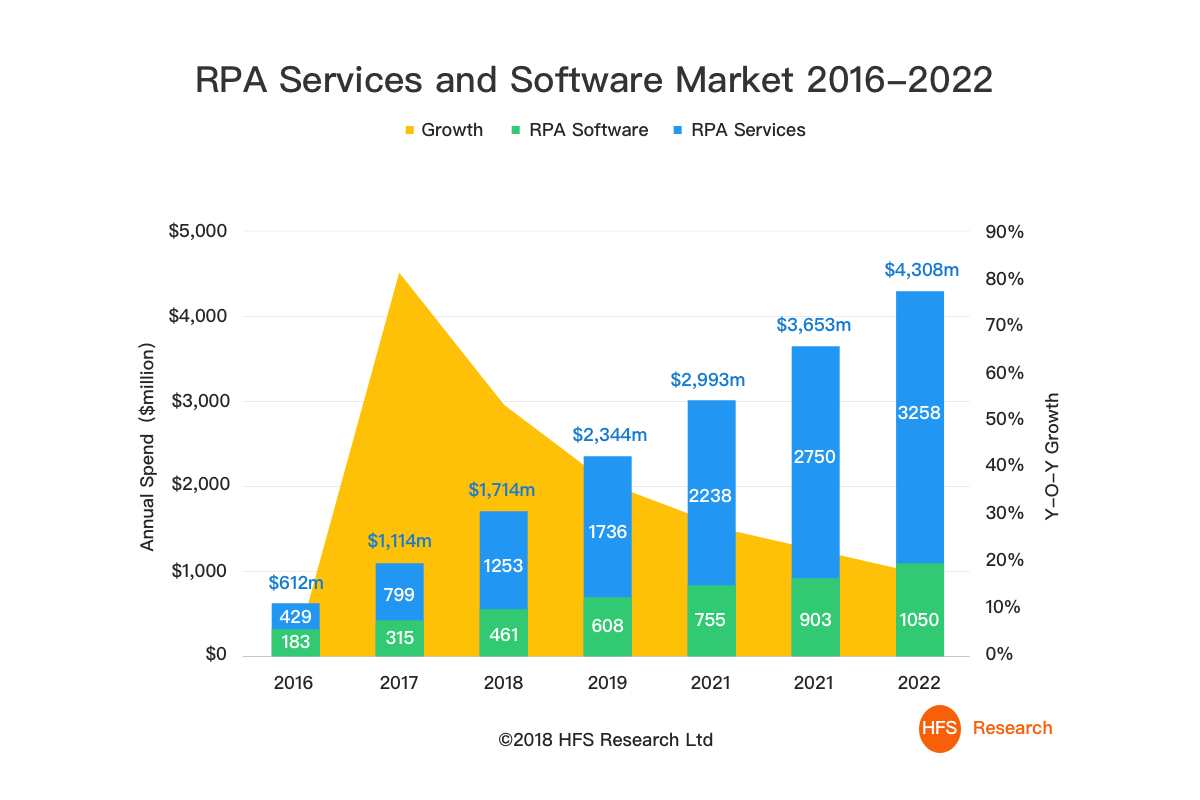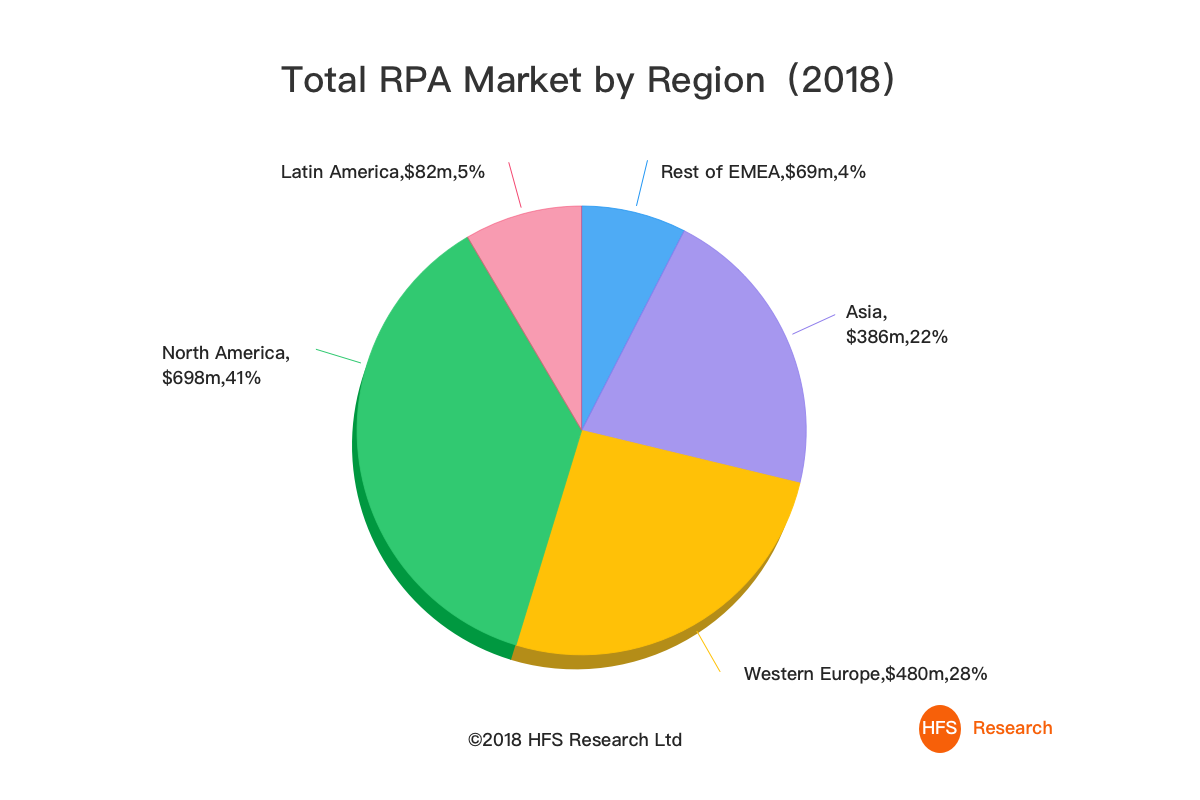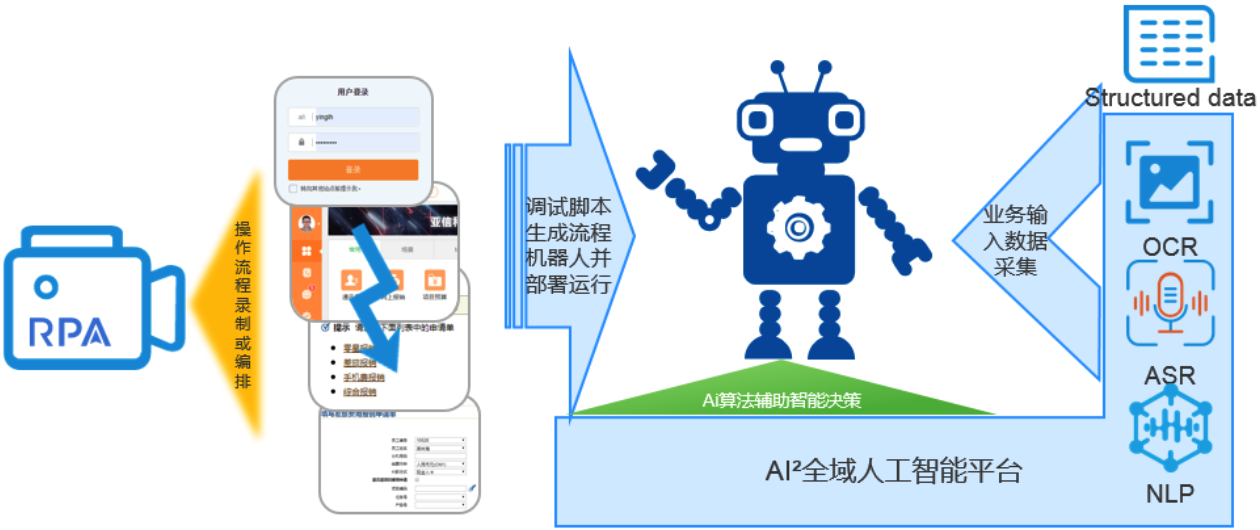2020-09-18
RPA (Robotic Process Automation) is a technology that realizes the automation of workflow by simulating and enhancing the interaction process between humans and computers. It can simulate the operations of humans on computers, and is especially expert in clicking, copying, pasting, inputting and other office contents with fixed rules and high repetitiveness, and is more efficient, agile and accurate than humans.
The year of 2019 has witnessed hundreds of millions of financing and the influx of players overwhelming the racetrack of RPA, therefore, 2019 is called the “First Year of RPA” of China. Although RPA has only become a buzzword in IT industry at the moment, its concept is not uncommon. For example, the “Macro” function of Office can define a general template in advance to automatically perform repetitive tasks. Such typical embedded automation library can be regarded as the predecessor of RPA. Afterwards, limited by factors such as technology and cost, RPA can only be applied to large enterprises, and is basically customized according to their own circumstances. With the rapid development of screen capture, management of business process automation, AI and other technologies in the last two years, RPA has ranked among the fastest-growing leading echeloning in the global software market segmentation.
I. RPA industry trend
According to Deloitte’s 2017 survey, an average of 20% of full-time equivalents in enterprises can be replaced by robots. A huge market undoubtedly emerges from this demand. Gartner’s latest research shows that the global RPA expenditure in 2019 was approximately USD 680 million, with a year-on-year growth of 57%. It is estimated that by the end of 2022, 85% of large and very large organizations will deploy RPA in certain form, and RPA software expenditure will reach USD 2.4 billion. Consulting agencies such as KPMG and consulting firm Zinnov have given more positive expectations: The global market share of RPA may exceed USD 100 billion.


II. AI makes IPA possible
In the practice of RPA, it is found two conditions must be met for RPA to fully play its role: First of all, there must be very clear and fixed processes and steps, so that the program can automatically complete tasks according to established rules; secondly, the process is required not to involve complex tasks or complex objects such as the integration of online and offline, and the process of nonstructural data, etc.
The introduction of AI technology makes RPA more widely used, breaks up the limitation of the above two conditions, expands the breadth and depth of process automation to move from automation to intelligence. AI can realize the processing of some businesses with relatively flexible processes, so that the program will have certain cognition, learning and reasoning capabilities, and output some decisions. The introduction of AI technologies such as speech recognition, object recognition, image recognition, OCR (character recognition) enables RPA to process more complicated nonstructural objects, and connect the physical world and the information world. These AI technologies are combined with automation to provide customers with more valuable products and solutions.
How to use technologies such as AI, machine learning and natural language processing to realize functions such as nonstructural data processing, prediction norm analysis, complex business logic, self-adaptation of variable scenarios, automatic task assignment and collaborative optimization, and to complete the transformation from process automation (RPA) to process intelligence (AI+RPA)? IPA (Intelligent Process Automation) will be the new direction of RPA development in the future.
III. AISWare AIRPA for advancing from RPA to IPA
AISWare AIRPA, the robotic process intelligent R&D platform of AsiaInfo, combines software process automation and AsiaInfo’s “smart brain” to provide cross-platform, cross-system and cross-application process integration capabilities, reduces high repetitiveness and low efficiency routine work through automation, realizes automatic discovery of process data anomalies, automatic identification of process changes and automatic accumulation of process knowledge through data intelligence. AISWare AIRPA continues to explore the internal efficiency bottlenecks and value vacancy of enterprise, promotes the intelligent remodeling of process, improves quality, efficiency and innovation agility in order to continuously advance from RPA to IPA.
Based on AI technologies such as OCR, NLP and ASR, AISWare AIRPA of AsiaInfo enables robots to have abilities of intelligent cognition, perception and decision-making, thereby realizing intelligent automatic process. Compared with traditional RPA, AISWare AIRPA has the following functions on its way to IPA:
1. Visual ability: Through computer vision technology, robots can recognize the change and position of the computer interface and provide assistance for the context;
2. Cognitive ability: Automatically detection of language, in combination with optical character recognition (OCR), natural language processing (NLP) and other technologies to extract nonstructural data and understand the meaning of the text to serve as the basis for decision-making;
3. Decision-making ability: In addition to automatically performing repetitive and regular tasks, it also has the analytical and decision-making ability beyond the rules based on the context.
IV. AISWare AIRPA platform architecture

Development tools: Provide graphical drag-drop process development tools to realize a visual and componentized RPA development environment, improve robot development efficiency and reduce the threshold of process production in an autonomous, easy and flexible way;
Management platform: Provide management of components, robot installation packages and execution node resources, establish execution plans based on business rules, and provide unified management and data chart display of task status, task execution results and other information to achieve visual centralized management and control;
Robot engine: Simulate the manual operation and interaction of users, comply with existing security and data integrity requirements, achieve the access to business systems in exactly the same way as manual operations based on the execution plans and through non-intrusive execution of business processes to avoid human errors, and record the execution log.

V. Product advantages of AISWare AIRPA
1. Graphical interface: Plentiful visual components support the drag-drop design of robots, which can flexibly respond to different business scenarios;
2. Easy integration with AI: It is very easy to integrate with AI services through AI components, remote calls and scripts;
3. Personalized service: The product can meet the actual needs of users, respond to needs in a timely manner, and provide intelligent processing and decision-making;
4. Satisfy the demands of the whole industry: Satisfy the RPA demands of the whole industry, and understand the telecom industry business better.
VI. What does AISWare AIRPA bring to customers?
1.In terms of business: Reduce cost
Realize the application effect featuring simple operation, flexible deployment and reliable implementation, reduce manual intervention, solve the problems of business processing such as large workload, mechanical duplication and low data quality, which better simplifies the process, reduces the error rate, reduces the processing time and decreases the overall cost;
2. In terms of operation: Agility
Expand the scope of data collection, quickly perceive and respond to process improvement demands caused by business expansion, strategic adjustments and changes in laws and regulations, and enhance operational insights to help reshape business models. For example: In the intelligent operation of risk control data of a customer’s financial department, the credit profiles of partners are accurately portrayed to complete the risk assessment in time. So far, 17500+ times of enterprise information inquiry and analysis have been carried out;
3. In terms of operations: Add intelligence
Provide the capabilities such as automated processing, visual statistical analysis and intelligent early warning. For example: In the intelligent audit of outsourced maintenance work order of an operator’s network, it takes about 7 minutes to process a single work order by traditional manual labor, while using AISWare AIRPA robots to audit a work order only takes 1.5 minutes, with the overall efficiency increased by more than 4 times;
4. In terms of management: Improve efficiency
Realize a 7*24*365, accurate, efficient, transparent and traceable work model, devote human resources to high-value-added analytical and strategic tasks, improve human resource efficiency and management compliance, and strengthen the security of corporate assets.
VII. Application cases of AISWare AIRPA
AISWare AIRPA is committed to the rapid construction of virtualized labor to provide users with simple, efficient and flexible robotic process automation and intelligent solutions. Since the launch of the product, it has been widely used in government affairs, telecommunications and other industries.
Case 1: Construction of a smart approval platform for the administrative approval bureau of a city in Anhui
AsiaInfo assisted this municipal government to complete the construction of “Characteristic Smart Approval Platform”, realizing 100% online approval of 42 matters allocated for approval, launching a total of 10 special services of “Doing One Thing Well”, and training an intelligent approval model to gradually achieve zero participation of manual work and quick handling in one minute. The platform is developed based on AISWare AIRPA and innovatively uses the domestic advanced “AI+RPA” technology, which can break the “data chimney” of government affairs, transform the reporting process, further implement the reform requirement of “All-In-One”, and accelerate the construction of a service-oriented digital government;
Case 2: The revenue account audit robot of a telecom operator
The revenue account audit robot crawls basic enterprise information from the Internet, and realizes the portrait of credit profile of partners of the finance department through AI risk control model training to complete risk assessment. Currently, 18W+ enterprise information inquiries have been completed and provided to the provincial corporate finance department;
Case 3: The intelligent audit robot for general work orders of outsourced maintenance platform of a telecom operator
After logging into the system, the intelligent audit robot for general work orders of outsourced maintenance platform obtains the task pool list, identifies the semantics of the work order text in combination with AI, audits the work orders according to the audit points, and feeds back the results. The robot reduces the processing time of a single work order from 7 minutes to 1.5 minutes, with the overall efficiency increased by more than 4 times;
Case 4: The intelligent audit robot for recharging and embedding of a telecom operator
The intelligent audit robot for recharging and embedding downloads a large amount of recharging embedded data in the system, and calls the AI capability to check the revenue data. The robot shortens the audit time from 30 minutes to about 4 minutes, and improves the efficiency by about 7 times, with an accuracy rate of 100%;
Case 5: The automatic order sorting robot of a telecom operator
After importing the manually generated reports into the system, the automatic sorting robot uses the AI automatic sorting model according to current operation status of work orders to realize the order sorting by two ways of the employee and time period;
Case 6: The intelligent automatic order filling robot of IT operations system of a telecom operator
The automatic order filling business process of IT operations system includes four steps: obtaining the information of AI simulation of manual order filling, automatically filling in task orders, uploading attachments, and calling back interface. It takes 4 minutes to compare the information for filling in an order, while the AISWare AIRPA robot can fill in an order in one minute, which improves the efficiency by more than 4 times;
Case 7: The intelligent order filling robot for CRM government-enterprise business of a telecom operator
According to the order information submitted by the account manager, the order filling process robot for CRM government-enterprise business pre-judges the compliance of the contents filled and automatically enters orders in system, submits the orders and generates the contracts through AI capabilities. The robot reduces the time spent on a single contract from 10 minutes to 2 minutes, improving the efficiency by more than 5 times and greatly increasing the approval passing rate.